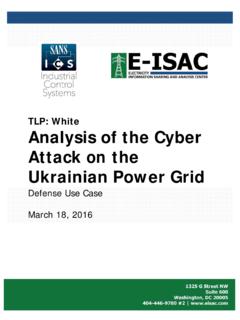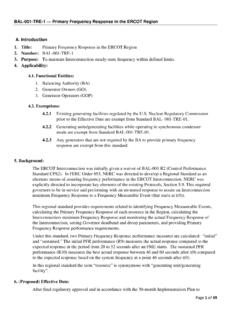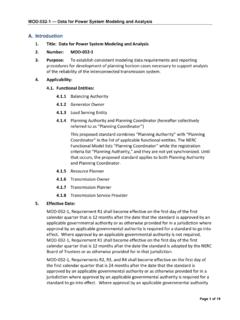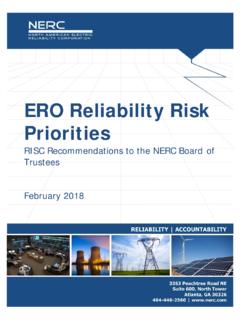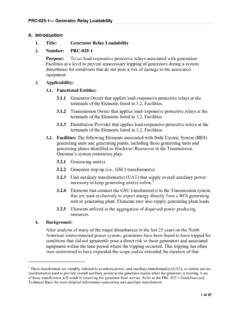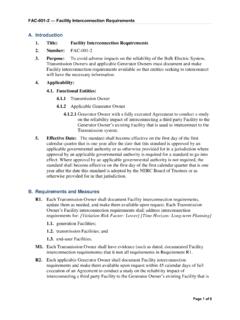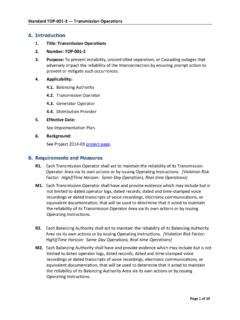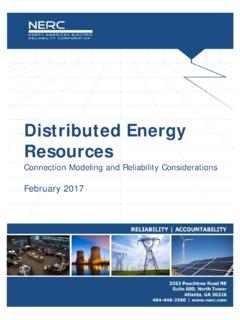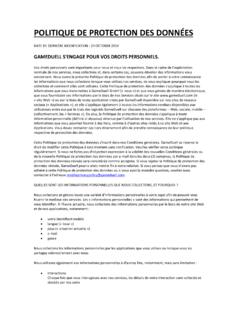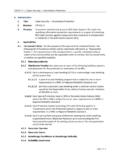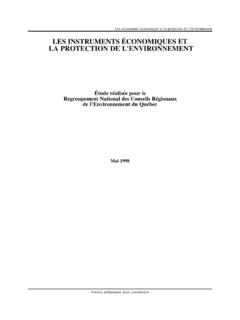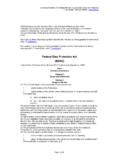Transcription of A. Introduction 1. Title - nerc.com
1 Standard PRC-019-2 Coordination of Generating Unit or Plant Capabilities, Voltage Regulating Controls, and protection Page 1 of 11 A. Introduction 1. Title : Coordination of Generating Unit or Plant Capabilities, Voltage Regulating Controls, and protection 2. Number: PRC-019-2 3. Purpose: To verify coordination of generating unit Facility or synchronous condenser voltage regulating controls, limit functions, equipment capabilities and protection System settings. 4. Applicability: Functional Entities Generator Owner Transmission Owner that owns synchronous condenser(s) Facilities For the purpose of this standard, the term, applicable Facility shall mean any one of the following: Individual generating unit greater than 20 MVA (gross nameplate rating) directly connected to the Bulk Electric System. Individual synchronous condenser greater than 20 MVA (gross nameplate rating) directly connected to the Bulk Electric System.
2 Generating plant/ Facility consisting of one or more units that are connected to the Bulk Electric System at a common bus with total generation greater than 75 MVA (gross aggregate nameplate rating). This includes individual generating units of the dispersed power producing resources identified through Inclusion I4 of the Bulk Electric System definition where voltage regulating control for the facility is performed solely at the individual generating unit of the dispersed power producing resources. Any generator, regardless of size, that is a blackstart unit material to and designated as part of a Transmission Operator s restoration plan. 5. Effective Date: See the Implementation Plan for PRC-019-2. B. Requirements R1. At a maximum of every five calendar years, each Generator Owner and Transmission Owner with applicable Facilities shall coordinate the voltage regulating system controls, (including in-service1 limiters and protection functions) with the applicable 1 Limiters or protection functions that are installed and activated on the generator or synchronous condenser.
3 Standard PRC-019-2 Coordination of Generating Unit or Plant Capabilities, Voltage Regulating Controls, and protection Page 2 of 11 equipment capabilities and settings of the applicable protection System devices and functions. [Violation Risk Factor: Medium] [Time Horizon: Long-term Planning] Assuming the normal automatic voltage regulator control loop and steady-state system operating conditions, verify the following coordination items for each applicable Facility: The in-service limiters are set to operate before the protection System of the applicable Facility in order to avoid disconnecting the generator unnecessarily. The applicable in-service protection System devices are set to operate to isolate or de-energize equipment in order to limit the extent of damage when operating conditions exceed equipment capabilities or stability limits. R2. Within 90 calendar days following the identification or implementation of systems, equipment or setting changes that will affect the coordination described in Requirement R1, each Generator Owner and Transmission Owner with applicable Facilities shall perform the coordination as described in Requirement R1.
4 These possible systems, equipment or settings changes include, but are not limited to the following [Violation Risk Factor: Medium] [Time Horizon: Long-term Planning]: Voltage regulating settings or equipment changes; protection System settings or component changes; Generating or synchronous condenser equipment capability changes; or Generator or synchronous condenser step-up transformer changes. C. Measures M1. Each Generator Owner and Transmission Owner with applicable Facilities will have evidence (such as examples provided in PRC-019 Section G) that it coordinated the voltage regulating system controls, including in-service2 limiters and protection functions, with the applicable equipment capabilities and settings of the applicable protection System devices and functions as specified in Requirement R1. This evidence should include dated documentation that demonstrates the coordination was performed.
5 M2. Each Generator Owner and Transmission Owner with applicable Facilities will have evidence of the coordination required by the events listed in Requirement R2. This evidence should include dated documentation that demonstrates the specified intervals in Requirement R2 have been met. 2 Limiters or protection functions that are installed and activated on the generator or synchronous condenser. Standard PRC-019-2 Coordination of Generating Unit or Plant Capabilities, Voltage Regulating Controls, and protection Page 3 of 11 D. Compliance 1. Compliance Monitoring Process Compliance Enforcement Authority The Regional Entity shall serve as the Compliance enforcement authority unless the applicable entity is owned, operated, or controlled by the Regional Entity. In such cases the ERO or a Regional entity approved by FERC or other applicable governmental authority shall serve as the CEA.
6 Evidence Retention The following evidence retention periods identify a period of time an entity is required to retain specific evidence to demonstrate compliance. For instances where the evidence retention specified below is shorter than the time since the last compliance audit, the Compliance Enforcement Authority may ask an entity to provide other evidence to show that it was compliant for the full time period since the last audit. The Generator Owner and Transmission Owner shall retain evidence of compliance with Requirements R1 and R2, Measures M1 and M2 for six years. If a Generator Owner or Transmission Owner is found non-compliant, the entity shall keep information related to the non-compliance until mitigation is complete and approved or for the time period specified above, whichever is longer. The Compliance Enforcement Authority shall keep the last periodic audit report and all requested and submitted subsequent audit records.
7 Compliance Monitoring and Assessment Processes Compliance Audit Self-Certification Spot Checking Compliance Investigation Self-Reporting Complaint Additional Compliance Information None Standard PRC-019-2 Coordination of Generating Unit or Plant Capabilities, Voltage Regulating Controls, and protection Page 4 of 11 2. Violation Severity Levels R # Lower VSL Moderate VSL High VSL Severe VSL R1 The Generator Owner or Transmission Owner coordinated equipment capabilities, limiters, and protection specified in Requirement R1 more than 5 calendar years but less than or equal to 5 calendar years plus 4 months after the previous coordination. The Generator Owner or Transmission Owner coordinated equipment capabilities, limiters, and protection specified in Requirement R1 more than 5 calendar years plus 4 months but less than or equal to 5 calendar years plus 8 months after the previous coordination.
8 The Generator Owner or Transmission Owner coordinated equipment capabilities, limiters, and protection specified in Requirement R1 more than 5 calendar years plus 8 months but less than or equal to 5 calendar years plus 12 months after the previous coordination. The Generator Owner or Transmission Owner failed to coordinate equipment capabilities, limiters, and protection specified in Requirement R1 within 5 calendar years plus 12 months after the previous coordination. R2 The Generator Owner or Transmission Owner coordinated equipment capabilities, limiters, and protection specified in Requirement R1 more than 90 calendar days but less than or equal to 100 calendar days following the identification or implementation of a change in equipment or settings that affected the coordination. The Generator Owner or Transmission Owner coordinated equipment capabilities, limiters, and protection specified in Requirement R1 more than 100 calendar days but less than or equal to 110 calendar days following the identification or implementation of a change in equipment or settings that affected the coordination.
9 The Generator Owner or Transmission Owner coordinated equipment capabilities, limiters, and protection specified in Requirement R1 more than 110 calendar days but less than or equal to 120 calendar days following the identification or implementation of a change in equipment or settings that affected the coordination. The Generator Owner or Transmission Owner failed to coordinate equipment capabilities, limiters, and protection specified in Requirement R1 within 120 calendar days following the identification or implementation of a change in equipment or settings that affected the coordination. E. Regional Variances None. F. Associated Documents Underexcited Operation of Turbo Generators , AIEE Proceedings T Section 881, Volume 67, 1948, Appendix 1, C. G. Adams and J. B. McClure. , Protective Relaying For Power Generation Systems , Boca Raton, FL, Taylor & Francis, 2006, Reimert, Donald Standard PRC-019-2 Coordination of Generating Unit or Plant Capabilities, Voltage Regulating Controls, and protection Page 5 of 11 Coordination of Generator protection with Generator Excitation Control and Generator Capability , a report of Working Group J5 of the IEEE PSRC Rotating Machinery Subcommittee IEEE IEEE Guide for AC Generator protection IEEE IEEE Standard for Cylindrical-Rotor 50 Hz and 60 Hz Synchronous Generators Rated 10 MVA and Above Version History Version Date Action Change Tracking 1 February 7, 2013 Adopted by nerc Board of Trustees New 1 March 20, 2014 FERC Order issued approving PRC-019-1.
10 (Order becomes effective on 7/1/16.) 2 February 12, 2015 Adopted by nerc Board of Trustees Standard revised in Project 2014-01: Applicability revised to clarify application of requirements to BES dispersed power producing resources 2 May 29, 2015 FERC Letter Order in Docket No. RD15-3-000 approving PRC-019-2 Modifications to adjust the applicability to owners of dispersed generation resources. Standard PRC-019-2 Coordination of Generating Unit or Plant Capabilities, Voltage Regulating Controls, and protection Page 6 of 11 G. Reference Examples of Coordination The evidence of coordination associated with Requirement R1 may be in the form of: P-Q Diagram (Example in Attachment 1), or R-X Diagram (Example in Attachment 2), or Inverse Time Diagram (Example in Attachment 3) or, Equivalent tables or other evidence This evidence should include the equipment capabilities and the operating region for the limiters and protection functions Equipment limits, types of limiters and protection functions which could be coordinated include (but are not limited to): Field over-excitation limiter and associated protection functions.
